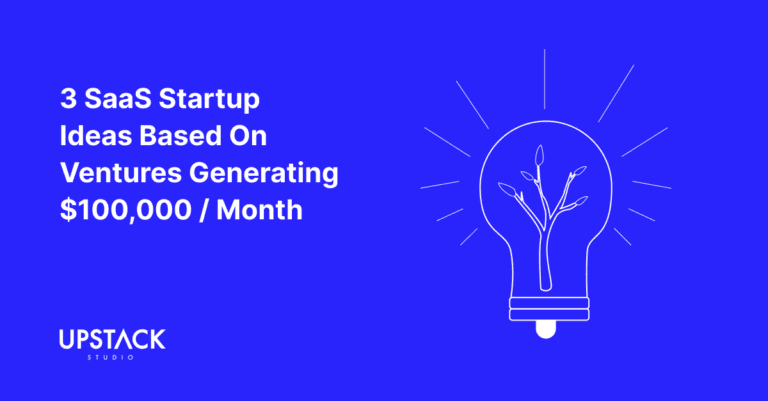A SaaS Product Is NOT a SaaS Business
No code app builders and the ease of hiring remote developers make building SaaS products easier than ever.
However, a SaaS product and SaaS company are not the same thing.

A great SaaS product is just one of five key pillars of a successful software business, and as it’s so resource-intensive, many founders inadvertently ignore the other pillars.
That’s why the world is full of good software products owned by bankrupt businesses.
In this post, we clarify these pillars to give new founders perspective on how much goes into starting, building, and growing a SaaS company.
Let’s begin.
5 Essentials of a Successful SaaS Business
Here are the four foundational pillars of every successful SaaS in the history of forever:
- Idea Validation
- Product Management
- Marketing
- Monetization strategy
- Business Entity & Compliance Knowledge
Let’s talk about what these mean in the context of a software business.
1. Idea Validation
If you want to follow the money, you want the biggest and richest total addressable market.
And you want to solve the most frequent and serious problem they face.

If you’re not sure where to start, our guide to finding software ideas can help you, though in summary we recommend turning to three sources:
- Work experience
- Life experience, and
- Secondhand research
And say you then identify ten problems that translate into ten SaaS ideas.
The current meta is to make a landing page to measure demand – if three out of every hundred visitors sign up, you’re onto something.
2. Product Management
As mentioned, a good product is essential, and goes under product management.
It spans pre-development requirement gathering, the development process itself, and post-development processes that go on indefinitely.

Regardless of what type of SaaS you’re building, development consists of six main steps:
- Requirements Gathering
- UI/UX Design
- Backend and Frontend Development
- QA & Testing
- Launch
And finally, the eternal cycle of
- Software maintenance and updating
That initial launch in Step 5 is for a minimum viable product or MVP.
Now, MVPs come in all shapes and sizes, but the original definition by the person who coined the term was “That version of a new product which allows a team to collect the maximum amount of validated learning about customers with the least effort.”
Your MVP isn’t meant to be perfect, it’s meant to be tested by real users who give feedback.
And then you and your team use that feedback to iterate your SaaS towards perfection.
In our experience, it’s reasonable to launch a market ready SaaS MVP in 12 weeks.
3. Marketing
This is where you do everything within your power and budget to make your total addressable market aware of your solution to their problem.
We’re no marketers so we’d feel a bit weird telling you how to market your SaaS.
That’s why we’ve turned to an expert on the topic: Ali Abouelatta.
He’s a Duolingo product manager and founder of the First 1000 blog, which does deep dives into how different SaaS products got their first 1000 customers.

We recommend reading his list of 53 things you can do to get to your first 1K customers.
You won’t actually need 53 different marketing strategies, so the idea is to go through the list and pick the ones that have the best synergy with your product.
4. Monetization Strategy
This is how your SaaS will reliably generate revenue and you must know two things:
- That it has the potential to generate the kind of revenue you need.
- Your price points are competitive enough to keep paying users
We’ve dedicated an entire article to different software monetization strategies, in which we mentioned the following options:
- In-app Advertising
- In-app Purchases
- Renewable Subscriptions
- White Labeling
- Crowdfunding
- Corporate / Public Sponsorship
- Data Monetization
It’s not an exhaustive list – there are more ways to make money from SaaS, but just because you can, doesn’t mean you should!
User-based monetization
If you plan to generate revenue directly from users, your monetization strategies are:
- Subscriptions, and
- In-app purchases
On average, 2- 5% of users will make the jump to a paid plan, so account for this when setting your pricing.
Traffic-based monetization
If you plan to generate revenue from selling your traffic to other businesses, you’re looking at data monetization or advertising.
With ads, you’ll need to read up on cost per mille which is how much you get paid for every one thousand impressions.
There are a LOT of factors that affect cost per mille, including
- type of ad,
- type of app,
- where your users are located,
- where the ad is placed,
It’s impossible to make blanket statements as rates between countries aren’t just different, they can be the complete opposite!
Also, you need hundreds of thousands of active users per day to make ad revenue worthwhile. It’s doable, just very hard.
We’d personally recommend a subscription model whenever possible, or both.
5. Business Entity & Compliance Knowledge
For your SaaS to be legitimate, you need to incorporate a business entity and fulfill local statutory obligations.
For example, most businesses in Malaysia incorporate a Sendirian Berhad (Sdn Bhd), our version of a private limited liability company (LLC).
Operating a company with statutory compliance demands such as:
- Appointing directors and company secretaries
- Applying for the right business licenses from authorities
- Filing annual and corporate tax returns
It seems tedious (because it is), but skipping it risks serious consequences—fines, shutdowns, or even imprisonment, depending on your country’s laws.
As a bonus, a registered business boosts credibility and opens doors to clients you’d otherwise never get.
Ranking the 5 SaaS Business Essentials
Starting with the most to least important, our list of SaaS business essentials is as follows:
- Idea validation
- Marketing
- Product managemen
- Monetization strategy
- Entity & Compliance
Just to be clear, a truly successful SaaS business needs all five.
But you can probably neglect some and still make a bit of money.
Others, you neglect and you have nothing.

So we’re not saying these pillars are unimportant – we’re saying they’re not all equally important, and we’re sharing this to help you decide how to allocate your limited time and resources.
All the best!
Hey there stranger, thanks for reading all the way to the end. Consider joining our mailing list for a one-stop resource on everything from micro SaaS validation all the way to execution and promotion. Get a nifty list of questions to ask app developers when you sign up!
App Developer Interview Questions Template
Download this template now so you know exactly what to ask App Development Agencies! Let us know where should we send it through the form below.





